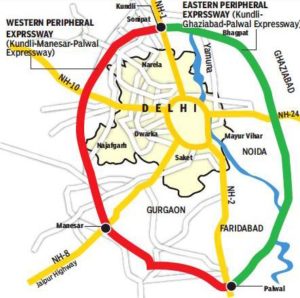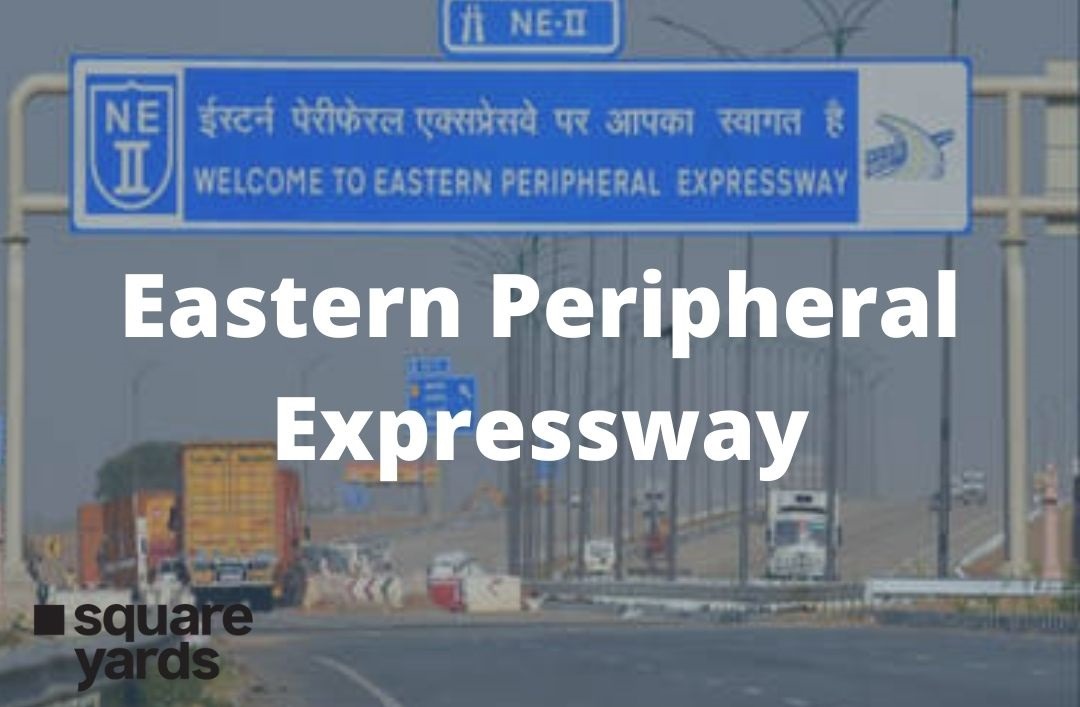Kundli–Ghaziabad–Palwal Expressway (KGP Expressway) or the Eastern Peripheral Expressway (EPE) is a six-lane expressway that is 135 km long. The Peripheral Expressway passes through the states of Uttar Pradesh and Haryana in India. It starts from the Western Peripheral Expressway in Kundli, Sonipat, and crosses Ghaziabad, Faridabad, Baghpat and then rejoins the Western Peripheral Expressway near Palwal. Declared as the National Highway 2, the Eastern Peripheral Expressway and the Western Peripheral Expressway make for the largest ring road around the national capital, Delhi.
Table of contents
- Eastern Peripheral Expressway map and route
- Find below the Eastern Peripheral Expressway map
- Eastern Peripheral Expressway toll rates
- Facts about Eastern Peripheral Expressway
- Speed limit at Eastern Peripheral Expressway
- Benefits of Eastern Peripheral Expressway
- Impact on Real Estate and Connectivity
- FAQ’s
Eastern Peripheral Expressway map and route
The Eastern Peripheral Expressway has been named the National Expressway-2 and passes through Ghaziabad, Baghpat, Faridabad, and Greater Noida in UP before it ends at Palwal. Sonipat is the starting point of the Eastern Peripheral Expressway route.
Find below the Eastern Peripheral Expressway map

Also Read:- KMP or Western Peripheral Expressway
Eastern Peripheral Expressway exit points
There are seven total Eastern Peripheral Expressway exit points for the commuters. These exit points are named after the villages it crosses through, such as Dadri, Duhai, Dasna, Baghpat, and Atali-Chasna which lead to Ghaziabad, Meerut, Noida, Moradabad, Faridabad, and Greater Noida.
Eastern Peripheral Expressway toll rates
As per an estimate, the prices for the entire Eastern Peripheral Expressway route are ₹190 for cars and ₹630 for buses and trucks. Here is the Eastern Peripheral Expressway toll charges list.
| Type of vehicle | Toll rate per km |
| Car/jeep | Rs 1.384 |
| Light commercial vehicle | Rs 2.237 |
| Truck/bus | Rs 4.687 |
| Heavy construction machinery (three-axle vehicle) | Rs 5.113 |
| Four to six-axle vehicles | Rs 7.350 |
| Oversized vehicles (> seven axle) | Rs 8.948 |
Facts about Eastern Peripheral Expressway
- With a feature of a closed tolling system, the commuters traveling on the Peripheral Expressway will only have to pay the toll for the distance traveled and not for the entire length of the highway.
- The provision for electronic collection of tolls or FASTag has been made so that it does not disrupt the flow of traffic.
- The Peripheral Highway has weigh-in-motion sensors that ensure that overloaded vehicles do not enter the highway. These sensors are installed at all entry points with two gates.
- There is also a provision of parking of the overloaded vehicles so that they can lay off the extra weight to match the given criteria.
- Approximately 2.5 lakh trees were planted all along the Peripheral Expressway. The drip irrigation system is used to water these plants.
- Along with the fact that it is the first green highway, there is also a provision for collecting rainwater at a distance of every 500 m.
- Both sides of the Eastern Peripheral Expressway have a 2.5 meters wide area for cycling.
- The Eastern Peripheral highway boasts of an automatic challan system. To keep in check the speed of the vehicles, cameras have been installed at different locations.
- Being the first green and smart highway of India, the Eastern Peripheral Expressway has solar panels installed to provide power to the lights along the road.
- The Peripheral Highway has a total of 406 structures which includes 46 minor bridges, 4 major bridges, seven interchanges, 3 flyovers, 8 Railway over Bridges (ROBs), and 221 underpasses.
- The entire cost of construction of the Eastern Peripheral Highway amounted to ₹11,000 crores.
- In order to curb pollution, fly ash from the coal power plants was used to construct 33% of the earthwork of the highway.
- It also possesses a Highway Traffic Management System (HTMS) and an intelligent Video Incident Detection System (VIDS).
- The entire construction of the Peripheral Highway was completed in a record time of 500 days.
- The amenities provided along the Peripheral Road are many including motels, restrooms, shops, restaurants, fuel outlets, and more. Many replicas of the famous Indian monuments have also been installed such as the India Gate, Qutub Minar, Hawa Mahal, Gujarat Carving, Char Minar, and more.
Also Read:- Bundelkhand Expressway
Speed limit at Eastern Peripheral Expressway
In comparison to other expressways, the Eastern Peripheral Expressway has a speed limit of 120 kmph. The talks of increasing the speed limit on the multi-lane corridors of the expressway.
Benefits of Eastern Peripheral Expressway
The EPE is bound to reduce the flow of traffic into the national capital and hence it is good news for the people who are sick of traffic in Delhi.
The level of pollution is also bound to decline with the help of the green and smart expressway. The Eastern Peripheral Expressway will help the people traveling to Haryana, UP, Punjab, Uttarakhand, and Jammu & Kashmir bypass Delhi which will reduce the level of pollution by 50%.
The Eastern Peripheral Highway will help connect the commuters of Haryana, UP, and Delhi and will increase accessibility.
The Eastern Peripheral Expressway and the Western Peripheral Expressway will hence form a ring around the national capital which will help in bringing Noida, Faridabad, and Ghaziabad closer to Delhi. The residential hub Ghaziabad and the industrial hub Faridabad for example will be connected in a better way.
Impact on Real Estate and Connectivity
The Eastern Peripheral Expressway has resulted in a boost in the real estate sector. Tier-III cities such as Kundli, Baghpat, and Palwal all lie along the Peripheral Expressway. The construction of this highway has led to an increase in the demand for affordable housing near eastern peripheral expressway. The investors in Delhi have pumped huge amounts of investment into these newly found real estate hotspots.
Commercial and residential properties are bound to grow in this area and it might become the most demanded area for the home buyers in NCR. This will result in the urbanization of these untapped areas.
The construction of this highway will lead to an increase in the demand for the property because of the increase in connectivity of residential and industrial hubs. The Eastern Peripheral Expressway crosses the Taj Expressway near Noida which will result in the rise of the property prices in Haryana, UP, and Delhi.
FAQ’s
Is Eastern Peripheral Expressway open?
Yes, the Eastern Peripheral Expressway is open to the public. It was inaugurated on 27th May 2018 by the Prime Minister, Narendra Modi. It was finally opened after 15 years since the announcement of the project and has made travelling easy for the people of Delhi.
Which is India's first smart and green highway?
Kundli-Ghaziabad-Palwal (KGP) Expressway or the Eastern Peripheral Expressway which is 135 km long is the country’s first green and smart highway.
Why is the Eastern Peripheral Expressway not connected to the Yamuna Expressway?
The National Highways Authority of India or NHAI which constructed the Eastern Peripheral Expressway was not able to connect the expressway with the Yamuna Expressway because of a land issue. But, the work to connect it with the Yamuna Expressway via an interchange has started.
Is Eastern Peripheral Expressway complete?
The Eastern Peripheral Expressway was fully operational in May 2018 after it was inaugurated by the PM. It has been connected to the Delhi-Meerut Highway and will also be connected to the Yamuna Expressway soon.





